Early one summer morning, Mohammed[1] stood among his grove of qat trees in a village south of the capital Sana’a in Sanhan district. Two local men, who work as Mohammed’s mubazigheen (pickers), were busy harvesting qat, plucking leaves, and placing them in plastic shopping bags. Every so often, Mohammed would step in to help, hiking up his crisp white thobe to reach the highest branches.
The war has made Mohammed’s small qat farm, around 2,640 square meters (.65 acres), less profitable than it once had been. The 45-year-old said he makes around US$33 a day from qat in the summer, when the harvest is plentiful due to the rainy season.[2] But this figure does not include his expenses, and Mohammed said he did not feel comfortable sharing his exact income, out of fear of competition. In the winter, a good crop can earn him more, as it fetches a higher price due to less supply in the market. “We tend to keep the trees with the best leaves for the winter,” Mohammed said.[3]
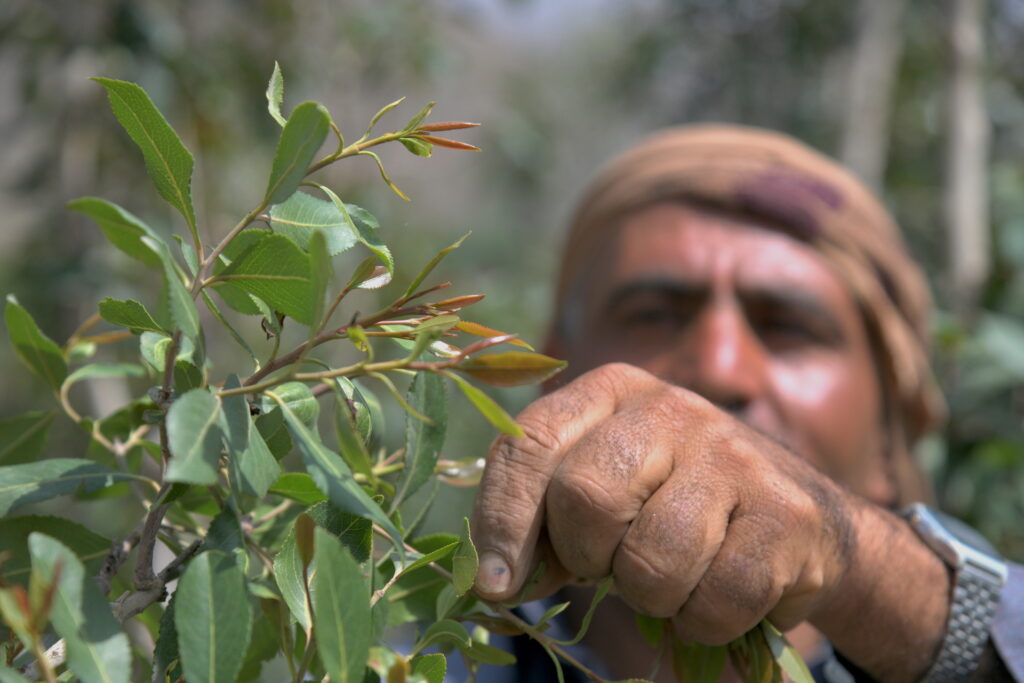
From his earnings, Mohammed pays the mubazigheen US$2 a day for their work, plus a bag of qat. Twice a year he pays someone to come plow his field.[4] “Our livelihood used to be really good,” Mohammed said of life before the war. He used to build new houses for his family from his qat income.[5] Now Mohammed said that he sometimes has to sell small parcels of land in order to provide for his family and cover expenses for his farm.[6] He needs about 100 liters of diesel a week[7] to power a water pump to irrigate his qat trees,[8] and must water them at least three times a month when it doesn’t rain: “If you abandon the qat, it’ll abandon you.”[9]
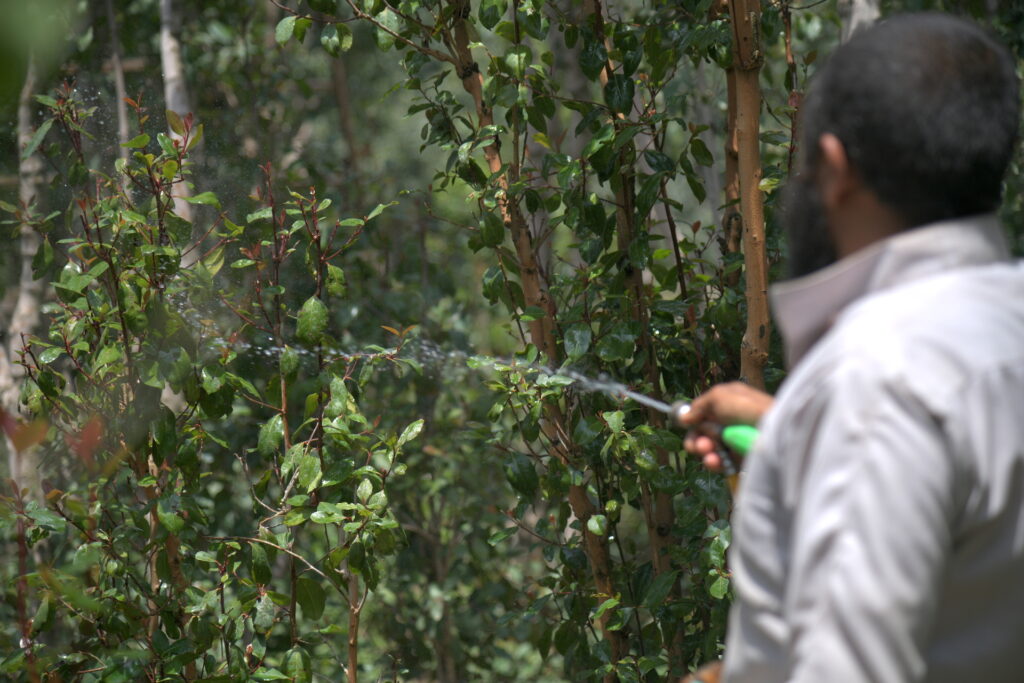
Qat farmers also pay zakat tax, which is collected annually and meant for redistribution to those in need, based on one of Islam’s main tenants. A 10 percent levy is applied to revenues from crops grown from rainwater, while crops that require irrigation from a pump are taxed at 5 percent.[10] However, farmers tend to report much lower annual incomes than their true figures, and tax authorities have little recourse in the matter. A zakat tax authority employee in Ibb governorate said that medium-scale farmers often report their annual income in the US$300-US$500 range in order to pay less in zakat.[11]
A deep-rooted tradition
Catha edulis — qat’s scientific name — grows on small, bushy trees found across East Africa and Yemen. It is consumed primarily in Ethiopia, Kenya, Djibouti, and Somalia, as well as in Yemen, where the vast majority of adult males consume the drug every day and about a third of the women are daily chewers.[12]
Qat originated in Ethiopia and was brought to Yemen some 700 hundred years ago,[13] though its exact origins and history of human consumption remain murky.[14] At the beginning of the twentieth century, it was considered a luxury and consumed mainly by the wealthy elite. At the same time, Yemen’s coffee trade was dwindling, due in part to European colonialism expanding global production. Yemeni coffee now had to compete with coffee from Java and the Americas.[15] In response, the imamate that ruled northern Yemen encouraged large landowners to replace coffee crops with qat.[16] Northern Yemen exported qat to what was then British-occupied southern Yemen, where growing qat was not yet common.[17] The money that could be made selling to the south further encouraged farmers to switch their crops.[18] As the twentieth century wore on, qat became less of a luxury due to increased cultivation, and its consumption became more popular among the rest of the population.[19] Soon, the afternoon qat chew would become a ubiquitous part of Yemeni culture, especially in the northern highlands.
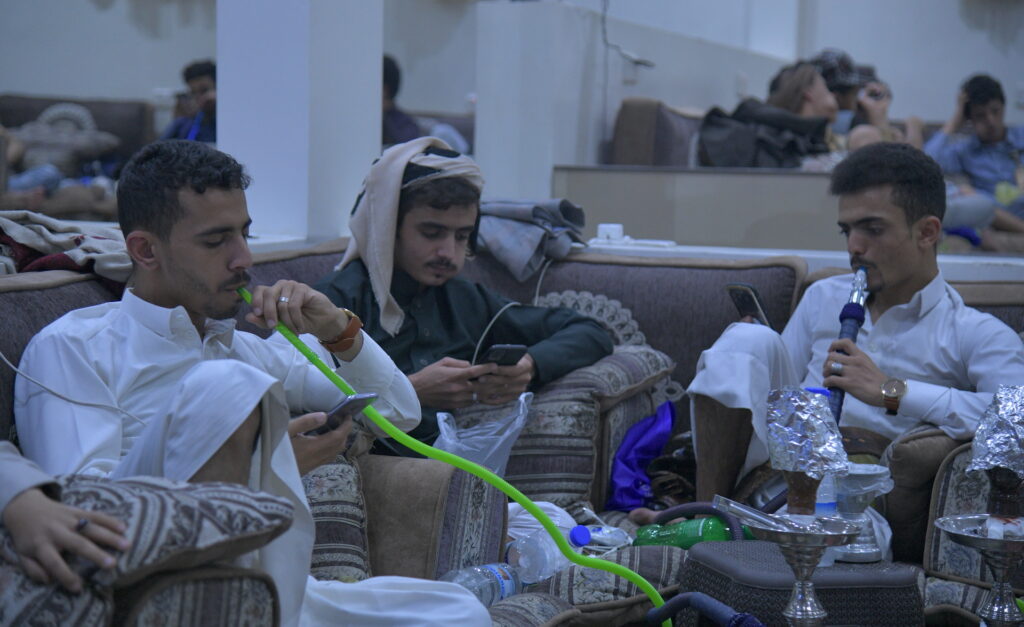
Qat now governs the pace of life in Yemen. Traditionally, especially in cities, there is a lunchtime rush when men run out to markets to buy their daily supply of the drug. After this comes the requisite qat chew, the afternoon hours when people gather together to consume qat, share stories, scheme about the future and, finally, relax, when the effects of the drug lull users into a more tranquil state. Qat is consumed by placing the tender leaves of the plant in one’s mouth, briefly chewing the leaves, and then storing them in the cheek for hours on end.
The workday in Yemen is only from 8 am until 2 pm, largely because of the importance of the afternoon qat chew, the takhzeenah. Group conversation during the chews often circles back to work issues, even though office hours are over. The genderedness of takhzeenahs — traditionally men and women chew separately — means that women are often left out of business conversations. Even during rounds of fighting, activity on the frontlines sometimes pauses in the afternoon so soldiers can chew.[20]
Qat is now grown in 18 of Yemen’s 21 governorates, but some 80 percent of the country’s crop is grown in just seven: Sana’a, Amran, Hajjah, Ibb, Dhamar, Taiz, and Al-Bayda.[21] The majority of cultivation is controlled by a group of elite landowners, the few Yemenis getting rich off the drug.[22] A 2008 study revealed that 64 percent of qat farms were owned by just 9 percent of farmers.[23] This upper echelon of elites, which some researchers have referred to as a qat lobby,[24] wield considerable political influence, and have worked to cement Yemen’s qat addiction despite the grave economic toll for many consumers.
The drug readily makes its way around the country, even during the current conflict. Most of the qat chewed in Sana’a comes from local farms, or Amran, Dhamar, Sa’ada, and Hajjah governorates. The qat sold in Taiz and Ibb is often grown locally, or in Hajjah and Dhamar, but includes the most popular types of qat from Sana’a governorate, like Arhabi. In Aden and other southern cities, qat typically comes from Al-Bayda and Al-Dhalea. It is possible to find qat from northern regions, like the Arhabi variety, as far away as Seyoun in Hadramawt.[25]
From farm to market
Mohammed is one of the small-scale qat farmers just trying to make a living. In the summer, each day he sells at most 15 small shopping bags worth of qat to a middleman, known as a mufawid. The mufawid pays Mohammed about 2,500YR, or US$4 at the time of reporting, for each bag, though this price rises and falls, and during other seasons he does not harvest daily.[26]
Mohammed sells to different mufawids. On one particular day in July 2021, he sold his qat to a mufawid from his village who was then responsible for transporting the qat to a market in Sana’a. At a checkpoint marking the border of Sana’a city, the mufawid transporting the qat must pay 20 percent of its value to the Houthi tax authority,[27] for which he receives a receipt.[28] This 20 percent tax is often manipulated, as mufawids bribe officials to undervalue their qat haul.[29]
One mufawid said he felt that he had paid increasingly higher taxes in Houthi-controlled Yemen over the past few years.[30] The man, who sells his qat in a village just outside Sana’a, says that he used to pay about US$7 in tax daily, but now pays about US$12 for the same value of qat.[31] A parliament employee in Houthi-controlled Yemen said the tax rate has not increased, it is simply that the Houthi authority is more effective at collecting taxes than previous regimes, and that mufawids had grown accustomed to corruption and tax avoidance.[32]
The transport of qat and its taxation at checkpoints works similarly in areas controlled by the internationally-recognized government, where the tax rate is the same,[33] but the government is less effective at collecting. Houthi authorities run their territory more akin to a police state, which makes collection easier.[34] Within territory in southern Yemen controlled by the Southern Transitional Council (STC), fees are collected at STC-run checkpoints, but it is not always clear where this money goes.[35]
When goods are transported from Houthi-controlled territory to areas controlled by the internationally recognized government or the STC, traders and merchants often avoid the different banknotes used in the two parts of the country by exchanging goods using Saudi riyals or US dollars.[36] Qat is no exception.[37] Qat that crosses the frontlines is often more expensive, as mufawid’s charge for transportation and the possibility of repeat taxation from the various authorities. A bag of Arhabi qat from northern Yemen often costs twice as much in Aden as it would cost in Sana’a.[38]
In places of active conflict, qat trucks cross frontlines early each morning with relative ease.[39] Their cars and trucks are known as the green crescent car, a play on Red Crescent, the humanitarian organization that has red crescents painted on their vehicles and are supposed to be left untouched by warring parties.[40] A mufawid from Sa’ada said that he continues to send large amounts of qat to Marib on a daily basis via a driver, who pays bribes and sometimes gifts qat at armed checkpoints along the way.[41] He delivers enough qat for approximately 100 chewers a day (approximately 60 kilograms of qat).[42] The vehicle sets off from Sa’ada around 9 pm and arrives at noon the next day in Marib, where the qat is distributed to two or three sellers.[43] The mufawid said it costs US$15 per 30 kilograms to get the qat to Marib, including taxes and bribes at checkpoints.[44] These costs are then passed on to the customer.
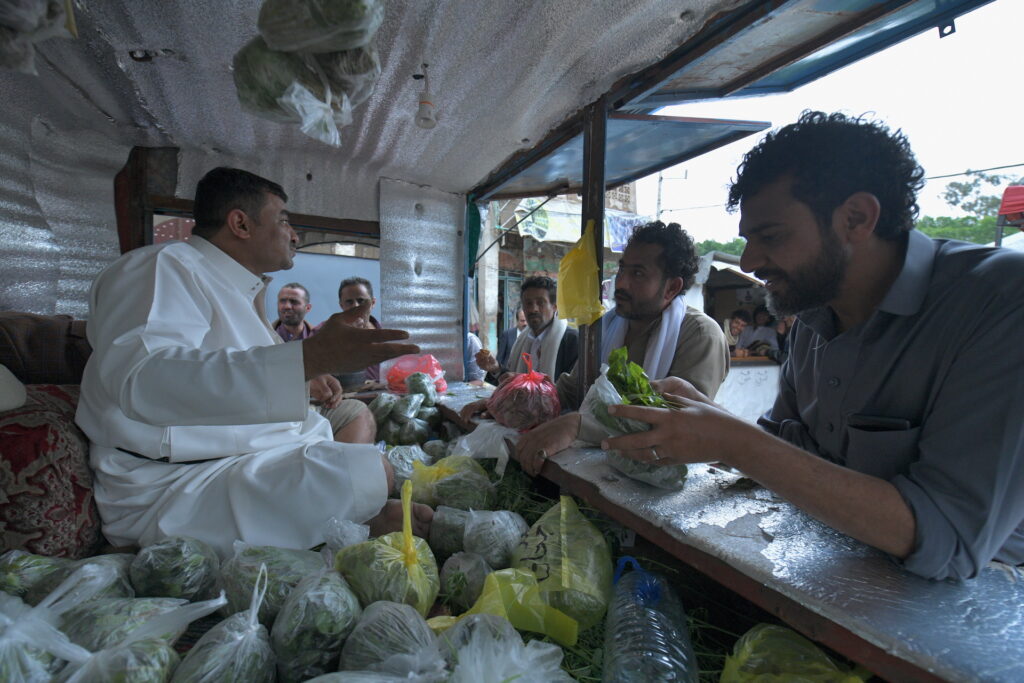
Mohammed’s qat is sold at Al-Hindiwanah market,[45] one of the dozens of qat markets in Sana’a, with outlets ranging in size from small shops to a large outdoor market that covers a city block. The qat sold at Al-Hindiwanah comes from Sanhan district, where Mohammed’s farm is located, and Khawlan district. At the market, one of the largest in Sana’a, around a hundred men sell bags of the leafy green plant. They sit on the backs of pickup trucks and on tops of tables inside small covered shacks. Those selling the cheapest qat sit on the ground. The mufawid sells Mohammed’s qat to whichever merchant, or muqawit, offers the best price.[46] A 23-year-old muqawit who maintains his own small stall at Al-Hindiwanah said he earns a net profit of around YR10,000 a day (approximately US$17) in the summer and 7,000YR (approximately US$12) a day in the winter.[47]
The future of qat
As the war continues and the country remains divided, Yemen’s reliance on the mild stimulant has only increased.[48] Qat depletes families’ meager incomes,[49] uses much of Yemen’s dwindling water supply,[50] and is one of the few goods allowed to cross frontlines.[51] As a cash crop, it represents a large portion of agricultural production in the country,[52] even if it’s not officially exported outside Yemen’s borders.[53] It has remained a prominent feature of daily life, at a time when little else is guaranteed. As beloved Yemeni poet Mohammed Mahmoud al-Zubairi wrote in 1958, “Qat is the first ruler of Yemen.”[54]
While the qat industry may be doing considerably better than other parts of the economy, addiction has left many families in terrible financial straits. Fathers marry off their daughters to settle qat debts.[55] Husbands frustrated by their inability to afford qat have turned to domestic violence.[56] Young men join militias, knowing that they’ll be compensated partly in qat.[57] Payment in qat is quite common in Yemen, especially by armed groups. The majority of Yemenis lack the financial means to afford both qat and daily necessities. A 2013 study found that some 20 percent of Yemeni families are in debt because of money spent on the drug.[58] Families’ financial situation has worsened with the economic crisis brought on by years of war, and qat prices have risen due to increasing diesel costs and a collapsing currency.
Despite the societal, economic, and environmental ills attached to Yemen’s qat dependence, extricating the drug from its prominent position in Yemeni culture is exceedingly difficult. Even though qat, as a daily habit, drives many individuals into poverty, it is its role in the larger economy that entrenches it as an important part of Yemeni life. This has not changed as the state has fractured.
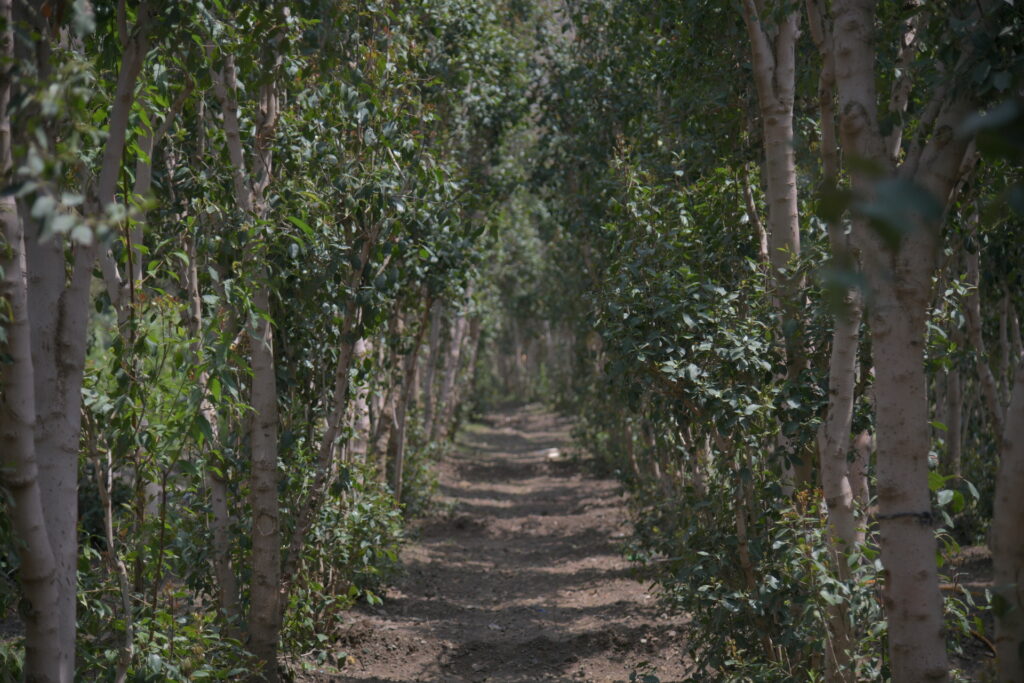
In the 1980s, before oil production and exportation began in earnest, qat production made up 30 percent of North Yemen’s GDP.[59] A 2007 paper published by the World Bank noted that qat cultivation made up a third of Yemen’s agricultural GDP.[60] A 2000 study found that the qat sector provided income to about 1 in 7 Yemenis, especially those that live in rural areas.[61] Moreover, with the downward spiral of Yemen’s economy after years of war and dwindling government salaries, people from other professions, such as teachers, have turned to the qat industry for work.[62]
Just as the future of the Yemeni state and the shape of its government remain in question as the war drags on, the outlook of qat production appears problematic given the country’s environmental woes, particularly its severe water crisis. Yemen has used more than one-third more water than is sustainable over the past few decades.[63] Qat uses more water than any other crop in Yemen, and accounts for 30 to 37 percent of consumption in the country.[64] A 2010 World Bank study predicted that Yemen’s groundwater reserves may be completely depleted in a few decades’ time.[65] Water scarcity, compounded by the effects of climate change,[66] has contributed to Yemen’s ongoing conflict.[67] This casts major doubts on the sustainability of qat production in its current form.
Yet qat’s significance in Yemen’s culture and economy remains steadfast. Qat addiction may be primarily psychological,[68] as opposed to the physical withdrawal symptoms of a narcotic, but its place in Yemeni society is paramount. To not chew qat means to not participate in what has become a fundamental part of Yemeni culture, particularly in the northern highlands. Meanwhile, farmers may earn far less from their qat farms than they used to, but there are few alternatives for employment — and so the trade continues.
A local journalist in Yemen contributed to this reporting.
- A pseudonym. All interview subjects in this piece have been granted anonymity.
- Interview, July 29, 2021.
- Interview, February 22, 2020.
- Interview, February 20, 2020.
- Ibid.
- Ibid.
- As of March 18, 2022, diesel cost approximately US$2 per liter on the black market.
- Interview, July 29, 2021.
- Ibid.
- Law no 2: Regarding Zakat from 1999 [AR], National Center for Information, Yemeni government, https://yemen-nic.info/db/laws_ye/detail.php?ID=11600#https://yemen-nic.info/db/laws_ye/detail.php
- Interview, February 10, 2022.
- “Toward Qat Demand Reduction,” The World Bank, June 2007, https://www.tni.org/files/publication-downloads/worldbank_qat-demand-reduction_2007.pdf
- Serge D. Elie, “State and Qat Consumption in Yemen: A Cultural Means to State Socialization,” April 2013, https://www.academia.edu/3391594/State_and_Qat_Consumption_in_Yemen_A_Cultural_Means_to_Political_Socialization
- Kevin Rushby, Eating the Flowers of Paradise, (Great Britain: Constable and Company Limited, 1998) p. 10.
- Anda Greeney, “Yemen’s Traditional and Resilient Coffee Sector: Production Totals Steady from 1960 to Present,” Harvard University, March 2022, https://dash.harvard.edu/bitstream/handle/1/37370751/Greeney Thesis Final.pdf?sequence=1
- Serge D. Elie, “State and Qat Consumption in Yemen: A Cultural Means to State Socialization,” April 2013, https://www.academia.edu/3391594/State_and_Qat_Consumption_in_Yemen_A_Cultural_Means_to_Political_Socialization
- Ibid.
- Ibid.
- Mustapha Rouis, “Yemen’s Qat Addiction Worsens,” World Bank Blog, March 20, 2014, https://blogs.worldbank.org/arabvoices/yemen-qat-addiction-worsens
- Mohammed Mukhashaf, “Despite Conflict, Qat is Out the Bag in Yemen,” Reuters, April 14, 2015, https://www.reuters.com/article/us-yemen-security-qat/despite-conflict-qat-is-out-the-bag-in-yemen-idUSKBN0N51F420150414
- Serge D. Elie, “State and Qat Consumption in Yemen: A Cultural Means to State Socialization,” April 2013, https://www.academia.edu/3391594/State_and_Qat_Consumption_in_Yemen_A_Cultural_Means_to_Political_Socializatio
- Paul Dresch, A History of Modern Yemen, (Cambridge: Cambridge University Press, 2000) p. 139.
- Cited in Marta Colburn, “Ethiopian Migrant Labourers on Qat Farms in Rada’, Yemen,” International Organization for Migration, 2014, https://www.academia.edu/59687764/Qat_yemen
- Serge D. Elie, “State and Qat Consumption in Yemen: A Cultural Means to State Socialization,” April 2013, https://www.academia.edu/3391594/State_and_Qat_Consumption_in_Yemen_A_Cultural_Means_to_Political_Socialization
- Interview with a Seyoun resident who confirmed the presence of Arhabi qat at a market in the city in April 2019.
- Interview, July 29, 2021.
- Houthi authorities generally followed the tax laws from the internationally recognized government, according to Peter Salisbury, then of International Crisis Group, author interview, March 4, 2022. See the following link from the National Center for Information on the Yemeni government’s tax law [AR]: https://yemen-nic.info/db/laws_ye/detail.php?ID=11343
- Interview, August 24, 2021.
- Stean Tshiband, “Qat, War and the Political Economy of Aid in Yemen,” Peace and Conflict Resolution Conference, 2019, https://www.academia.edu/43285460/Qat_War_and_the_Political_Economy_of_Aid_in_Yemen Stean Tshiband, “Qat, War and the Political Economy of Aid in Yemen,” Peace and Conflict Resolution Conference, 2019, https://www.academia.edu/43285460/Qat_War_and_the_Political_Economy_of_Aid_in_Yemen
- Interview, August 24, 2021.
- Ibid.
- Interview, September 7, 2021.
- Law No. (70) of 1991, On taxes on production, consumption and services [AR], National Center for Information, Yemen government, https://yemen-nic.info/db/laws_ye/detail.php?ID=11343
- Interview with Peter Salisbury, then of International Crisis Group, March 4, 2022.
- Interview with Peter Salisbury, then of International Crisis Group, March 21, 2022.
- Ibid.
- Interview with a middle man who operates between the farmer and qat sellers in Sa’ada governorate, February 5, 2022.
- Interview with an Aden-based journalist, March 17, 2022.
- Interview with a middle man who operates between the farmer and qat sellers in Sa’ada governorate, February 5, 2022.
- Ibid.
- Interview with a mufawid in Sa’ada governorate, March 4, 2022.
- Ibid.
- Ibid.
- Ibid.
- Interview, July 29, 2021.
- Interview, July 29, 2021.
- Interview, February 12, 2022.
- Stean Tshiband, “Qat, War and the Political Economy of Aid in Yemen,” Peace and Conflict Resolution Conference, 2019, https://www.academia.edu/43285460/Qat_War_and_the_Political_Economy_of_Aid_in_Yemen Stean Tshiband, “Qat, War and the Political Economy of Aid in Yemen,” Peace and Conflict Resolution Conference, 2019, https://www.academia.edu/43285460/Qat_War_and_the_Political_Economy_of_Aid_in_Yemen
- Ibid.
- Ibid.
- Interview with a middle man who operates between the farmer and qat sellers in Sa’ada governorate, February 5, 2022.
- Stean Tshiband, “Qat, War and the Political Economy of Aid in Yemen,” Peace and Conflict Resolution Conference, 2019, https://www.academia.edu/43285460/Qat_War_and_the_Political_Economy_of_Aid_in_Yemen Stean Tshiband, “Qat, War and the Political Economy of Aid in Yemen,” Peace and Conflict Resolution Conference, 2019, https://www.academia.edu/43285460/Qat_War_and_the_Political_Economy_of_Aid_in_Yemen
- Qat is regularly smuggled into Saudi Arabia and, less commonly, into Oman.
- Muhammad Mahmoud Al-Zubairi, “Satan in the Image of a Tree [AR],” Al-Arabi magazine, December 1, 1958.
- Dr. Fawziah Al-Ammar, Hannah Patchett and Shams Shamsan, “A Gendered Crisis: Understanding the Experiences of Yemen’s War,” Sana’a Center for Strategic Studies, December 15, 2019, https://sanaacenter.org/files/A_Gendered_Crisis_en.pdf
- Ibid.
- Ibid.
- Stean Tshiband, “Qat, War and the Political Economy of Aid in Yemen,” Peace and Conflict Resolution Conference, 2019, https://www.academia.edu/43285460/Qat_War_and_the_Political_Economy_of_Aid_in_Yemen Stean Tshiband, “Qat, War and the Political Economy of Aid in Yemen,” Peace and Conflict Resolution Conference, 2019, https://www.academia.edu/43285460/Qat_War_and_the_Political_Economy_of_Aid_in_Yemen
- Lamina RM and Lamina S, “The Chewing of Khat (Catha Edulis) in the Horn of Africa and Arabian Peninsula: Economic Overview,” Arabian Journal of Business and Management Review, September 2013, http://arabianjbmr.com/pdfs/OM_VOL_3_(2)/9.pdf
- “Yemen Toward Qat Demand Reduction,” The World Bank, June 2007, https://www.tni.org/files/publication-downloads/worldbank_qat-demand-reduction_2007.pdf
- Stean Tshiband, “Qat, War and the Political Economy of Aid in Yemen,” Peace and Conflict Resolution Conference, 2019, https://www.academia.edu/43285460/Qat_War_and_the_Political_Economy_of_Aid_in_Yemen Stean Tshiband, “Qat, War and the Political Economy of Aid in Yemen,” Peace and Conflict Resolution Conference, 2019, https://www.academia.edu/43285460/Qat_War_and_the_Political_Economy_of_Aid_in_Yemen
- Dr. Fawziah Al-Ammar, Hannah Patchett and Shams Shamsan, “A Gendered Crisis: Understanding the Experiences of Yemen’s War,” Sana’a Center for Strategic Studies, December 15, 2019, https://sanaacenter.org/files/A_Gendered_Crisis_en.pdf
- Helen Lackner and Abdulrahman al-Eryani, “Yemen’s Environmental Crisis Is the Biggest Risk for Its Future,” The Century Foundation, December 14, 2020, https://tcf.org/content/report/yemens-environmental-crisis-biggest-risk-future/?agreed=1
- Stean Tshiband, “Qat, War and the Political Economy of Aid in Yemen,” Peace and Conflict Resolution Conference, 2019, https://www.academia.edu/43285460/Qat_War_and_the_Political_Economy_of_Aid_in_Yemen Stean Tshiband, “Qat, War and the Political Economy of Aid in Yemen,” Peace and Conflict Resolution Conference, 2019, https://www.academia.edu/43285460/Qat_War_and_the_Political_Economy_of_Aid_in_Yemen
- “Assessing the Impacts of Climate Change and Variability on the Water and Agricultural Sectors and the Policy Implications,” The World Bank, April 22, 2010, https://openknowledge.worldbank.org/bitstream/handle/10986/2943/541960ESW0Gray1OFFICIAL0USE0ONLY191.pdf?sequence=1&isAllowed=y
- Helen Lackner and Abdulrahman al-Eryani, “Yemen’s Environmental Crisis Is the Biggest Risk for Its Future,” The Century Foundation, December 14, 2020, https://tcf.org/content/report/yemens-environmental-crisis-biggest-risk-future/?agreed=1
- Ibid
- Michael Odenwald, “Khat use and related addiction, mental health and physical disorders: the need to address a growing risk,” Eastern Mediterranean Health Journal, 2017, https://www.academia.edu/72770919/Khat_use_and_related_addiction_mental_health_and_physical_disorders_the_need_to_address_a_growing_risk

